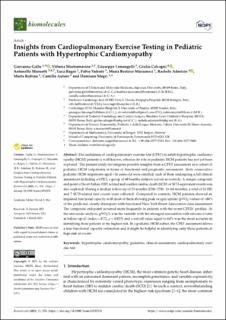Insights from cardiopulmonary exercise testing in pediatric patients with hypertrophic cardiomyopathy
Gallo, Giovanna; Mastromarino, Vittoria; Limongelli, Giuseppe; Calcagni, Giulio; Maruotti, Antonello; Ragni, Luca; Valente, Fabio; Musumeci, Beatrice; Adorisio, Rachele; Rubino, Marta; Autore, Camillo; Magrì, Damiano
Journal article, Peer reviewed
Published version

Åpne
Permanent lenke
https://hdl.handle.net/11250/2992450Utgivelsesdato
2021Metadata
Vis full innførselSamlinger
- Department of Mathematics [932]
- Registrations from Cristin [9489]
Sammendrag
The usefulness of cardiopulmonary exercise test (CPET) in adult hypertrophic cardiomyopathy (HCM) patients is well-known, whereas its role in pediatric HCM patients has not yet been explored. The present study investigates possible insights from a CPET assessment in a cohort of pediatric HCM outpatients in terms of functional and prognostic assessment. Sixty consecutive pediatric HCM outpatients aged <18 years old were enrolled, each of them undergoing a full clinical assessment including a CPET; a group of 60 healthy subjects served as controls. A unique composite end-point of heart failure (HF) related and sudden cardiac death (SCD) or SCD-equivalent events was also explored. During a median follow-up of 53 months (25th–75th: 13–84 months), a total of 13 HF- and 7 SCD-related first events were collected. Compared to controls, HCM patients showed an impaired functional capacity with most of them showing peak oxygen uptake (pVO2) values of <80% of the predicted, clearly discrepant with functional New York Heart Association class assessment. The composite end-point occurred more frequently in patients with the worst CPETs’ profiles. At the univariate analysis, pVO2% was the variable with the strongest association with adverse events at follow-up (C-index = 0.72, p = 0.025) and a cut-off value equal to 60% was the most accurate in identifying those patients at the highest risk. In a pediatric HCM subset, the CPET assessment allows a true functional capacity estimation and it might be helpful in identifying early those patients at high risk of events.
